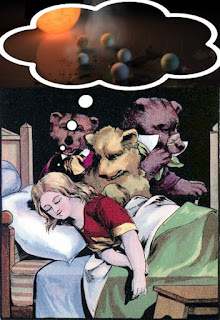Exoplanets: No Goldi-LUCKS Zone
When watching a television program recently, I heard a character use the old remark that since there are so many stars up yonder, there must be millions of inhabited planets as well. Interest in this obviously increased with the discovery of extrasolar planets.
Astrobiologists (astro, but no biology) and other scientists have come up with the habitable zone. It has to be just the right temperature so water can be present on a planet, and they expected to find a passel of thise planets. It did not go well.
 |
| Assembled from various public domain images, plus a modified NASA / JPL-Caltech image; they do not endorse this site |
...after looking through a catalog of over 4,000 known exoplanets (only 49 of which were deemed in the habitable zone) and measuring them against the additional set of criteria, they concluded that only 8 of those 49 planets made the cut. Then after looking more closely at the remaining eight, they decided that most likely seven of those were gas giants and not an Earth-like rocky planet. Typically, planets larger than 1.7 times the size of the Earth are considered gassy planets. The one remaining planet just squeaks by the size requirements, being 1.63 times the size of Earth.
You can read the entire article at "Goldilocks Is Dead: Exoplanets Are Inhospitable to Life."